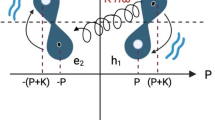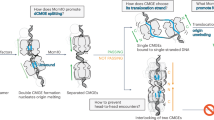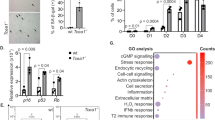Abstract
Telomeric C–strand sequences form non–Watson–Crick base–paired structures in supercoiled plasmids and in oligonucleotides at low pH. Here we examine oligonucleotides composed of 2 or 4 repeats of the human telomeric C–strand sequence d(CCCTAA)n. At low pH, the 2–repeat molecule forms a dimer which exhibits H1′–H1′ nuclear Overhauser effects (NOEs) between stacked C·C+ base pairs. These NOEs are characteristic of the i–motif, which is a tetraplex composed of two intercalated C·C+ duplexes. The 4–repeat molecule forms an intramolecular monomeric structure at low pH, suggesting that four contiguous cytosine tracts fold into a C·C+ intercalated tetraplex. These unusual structures may be relevant to the formation of guanine tetraplexes by complementary G–rich sequences. They may also provide a general mechanism for self–recognition by nucleic acids.
This is a preview of subscription content, access via your institution
Access options
Subscribe to this journal
Receive 12 print issues and online access
$189.00 per year
only $15.75 per issue
Buy this article
- Purchase on Springer Link
- Instant access to full article PDF
Prices may be subject to local taxes which are calculated during checkout
Similar content being viewed by others
References
Blackburn, E.H. Structure and function of telomeres. Nature 350, 569–573(1991).
Greider, C.W. Telemers. Curr. Opin. Cell Biol. 3, 444–451 (1991).
Henderson, E. & Blackburn, E.H. An overhanging 3′ terminus is a conserved feature of telomeres. Molec. cell. Biol. 9, 345–348 (1989).
Williamson, J.R. G-quartets in biology: reprise. Proc. natn. Acad. Sci. U.S.A. 90, 3124 (1993).
Kang, C.H., Zhang, X., Ratliff, R., Moyzis, R. & Rich, A. Crystal structure of four-stranded Oxytricha telomeric DNA. Nature 356, 126–131 (1992).
Smith, F.W. & Feigon, J. Quadruplex structure of Oxytricha telomeric DNA oligonucleotides. Nature 356, 164–168 (1992).
Sen, D. & Gilbert, W. A sodium-potassium switch in the formation of four-stranded G4-DNA. Nature 344, 410–414 (1990).
Sundquist, W.I. & Klug, A. Telomeric DMA dimerizes by formation of guanine tetrads between hairpin loops. Nature 342, 825–829 (1989).
Williamson, J.R., Raghuraman, M.K. & Cech, T.R. Monovalent cation-induced structure of telomeric DNA: the G-quartet model. Cell 59, 871–880 (1989).
Henderson, E., Hardin, C.C., Walk, S.K., Tinoco, I.J. & Blackburn, E.H. Telomeric DNA oligonucleotides form novel intramolecular structures containing guanine-guanine base pairs. Cell 51, 899–908 (1987).
Blackburn, E.H. & Szostack, J.W. The molecular structure of centromeres and telomeres. A. Rev. Biochem. 53, 163–194 (1984).
Oka, Y. & Thomas, C.A. The cohering telomeres of Oxytricha. Nucleic Acids Res. 15, 8877–8898 (1987).
Frank-Kamenetskii, M.D. The turn of the quadruplex? Nature 342, 737 (1989).
Sundquist, W.I. & Heaphy, S. Evidence for interstrand quadruplex formation in the dimerization of human inmmunodeficiency virus 1 genomic RNA. Proc. natn. Acad. Sci. U.S.A. 90, 3393–3397 (1993).
Marquet, R. et al. Dimerization of human immunodeficiencey virus (type 1) RNA: stimulation by cations and possible mechanism. Nucleic Acids Res. 19, 2349–2357 (1991).
Liu, Z., Frantz, J.D., Gilbert, W. & Tye, B.K. Identification and characterization of a nuclease activity specific for G4 tetrastranded DNA. Proc. natn. Acad. Sci. U.S.A. 90, 3157–3161 (1993).
Weisman-Shomer, P. & Fry, M. QUAD, a protein from hepatocyte chromatin that binds selectively to guanine-rich quadruplex DNA. J. biol. Chem. 268, 3306–3312 (1993).
Walsh, K. & Gualberto, A. MyoD binds to the guanine tetrad nucleic acid structure. J. biol. Chem. 267, 13714–13718 (1992).
Chung, I.K., Mehta, V.B., Spitzner, J.R. & Muller, M.T. Eukaryotic topoisomerase II cleavage of parallel stranded DNA tetraplexes. Nucleic Acids Res. 20, 1973–1977 (1992).
Schierer, T. & Henderson, E. A protein from Tetrahymena thermophila that specifically binds parallel-stranded G4-DNA. Biochemistry (in the press).
Fang, G. & Cech, T.R. The β subunit of Oxytricha telomere-binding protein promotes G-quartet formation by telomeric DNA. Cell 74, 875–885 (1993).
Gehring, K., Leroy, J.-L. & Guéron, M. A tetrameric DNA structure with protonated cytosine-cytosine base pairs. Nature 363, 561–565 (1993).
Leroy, J.-L., Gehring, K., Kettani, A. & Guéron, M. Acid multimers of oligodeoxycytidine strands:stoichiometry, base-pair characterization and proton exchange properties. Biochemistry 32, 6019–6031 (1993).
Patel, D.J. Tetrads through interdigitation. Nature 363, 499–500 (1993).
Ahmed, S. & Henderson, E. Formation of novel hairpin structures by telomeric C-strand oligonucleotides. Nucleic Acids Res. 20, 507–511 (1992).
Lyamichev, V.I. et al. An unusual DNA structure detected in a telomeric sequence under superhelical stress and at low pH. Nature 339, 634–637 (1989).
Belotserkovskii, B.P., Krasilnikova, M.M., Veselkov, A.G. & Frank-Kamenetskii, M.D. Kinetic trapping of H-DNA by oligonucleotide binding. Nucleic Acids Res. 20, 1903–1908 (1992).
Voloshin, O.N. et al. An eclectic DNA structure adopted by human telomeric sequence under superhelical stress and low pH. J. Biomol. Struct. Dyn. 9, 643–652 (1992).
De los Santos, C & Patel, D. NMR studies of DNA (R+)n·(Y−)n·(Y+)n triple helices in solution: imino and amino proton markers of T·A·T and G·G·C+ base triple formation. Biochemistry 28, 7282–7289 (1989).
Rajagopal, P. & Feigon, J. NMR studies of triple-strand formation from the homopurine-homopyrimidine deoxyribonucleotides d(GA)4 and d(TC)4 . Biochemistry 28, 7859–7870 (1989).
Zahler, A.M., Williamson, J.R., Cech, T.R. & Prescott, D.M. Inhibition of telomerase by G-quartet DNA structures. Nature 350, 718–720 (1991).
Sen, D. & Gilbert, W. Formation of parallel four-stranded complexes by guanine-rich motifs in DNA and its implications for meiosis. Nature 334, 364–366 (1991).
Ashley, T. & Ward, D.C. A “hot-spot” of recombination coincides with an interstitial telomeric sequence in the Armenian hamster. Cytogenet. cell. Genet. 62, 169–171 (1993).
Katinka, M.D. & Bourgain, F.M. Interstitial telomeres are hotspots for illegitimate recombination with DNA molecules injected into the macronucleus ofParamecium primaurelia. EMBO J. 11, 725–732 (1992).
Pluta, A.F. & Zakian, V.A. Recombination occurs during telomere formation in yeast. Nature 337, 429–433 (1989).
Hastie, N.D. & Allshire, R.C. Human telomeres: fusion and interstitial sites. Trends Genet. 5, 326–331 (1989).
Kintanar, A., Klevit, R.E. & Reid, B.R. Two-dimensional NMR investigation of a bent DNA fragment: assignment of the proton resonances and preliminary structural analysis. Nucleic Acids Res. 15, 5845–5862 (1987).
Sklenar, V. & Bax, A. Spin-echo water suppression for the generation of pure-phase two-dimensional NMR spectra. J. magn. Reson. 74, 469–479 (1987).
Jeener, J., Meier, B.H., Bachmann, P. & Ernst, R.R. Investigation of exchange processes by two-dimensional NMRspectroscopy. J. chem. Phys. 71, 4546–4553 (1979).
Plateau, P. & Guéron, M. Exhangeable proton NMR without baseline distortion, using new strong-pulse sequences. J. Am. chem. Soc. 104, 7310–7311 (1982).
Driscoll, P.C., Clore, G.M., Beress, L. & Gronenborn, A.M. A proton nuclear magnetic resonance study of the antihypertensive and antiviral protein BDS-I from the sea anemone Anemonia sulcata. Biochemistry 28, 2178–2187 (1989).
Braunschweiler, L. & Ernst, R.R. Coherence transfer by isotropic mixing: application to proton correlation spectroscopy. J. magn. Reson. 53, 521–528 1983).
Griesinger, C., Otting, G., Wüthrich, K. & Ernst, R.R. Clean TOCSY for 1H spin system identification in macromolecules. J. Am. chem. Soc. 110, 7870–7872 (1988).
States, D.J., Haberkorn, R.A. & Ruben, D.J. A two-dimensional nuclear Overhauser experiment with pure absorption phase in four quadrants. J. magn. Reson. 48, 286–292 (1982).
Author information
Authors and Affiliations
Rights and permissions
About this article
Cite this article
Ahmed, S., Kintanar, A. & Henderson, E. Human telomeric C–strand tetraplexes. Nat Struct Mol Biol 1, 83–88 (1994). https://doi.org/10.1038/nsb0294-83
Received:
Accepted:
Issue Date:
DOI: https://doi.org/10.1038/nsb0294-83
This article is cited by
-
Regulation of gene expression by targeting DNA secondary structures
Journal of Chemical Sciences (2021)
-
Chemical equilibria studies using multivariate analysis methods
Analytical and Bioanalytical Chemistry (2011)
-
CK2-dependent phosphorylation of the E2 ubiquitin conjugating enzyme UBC3B induces its interaction with β-TrCP and enhances β-catenin degradation
Oncogene (2002)
-
Protein kinase CK2 in mammary gland tumorigenesis
Oncogene (2001)
-
Extension of the four-stranded intercalated cytosine motif by adenine•adenine base pairing in the crystal structure of d(CCCAAT)
Nature Structural & Molecular Biology (1995)



